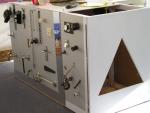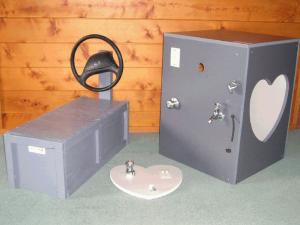I have given a presentation at the 24th International Conference on Solid Waste Technology and Management ‘Turning waste into learning experiences for children’ is a pictorial tour of creative ideas that have been added to the outdoor environment of early childhood centers. It includes innovative equipment I have designed and made for preschool children, which are predominantly made from solid waste materials. This presentation is about transforming someone else’s rubbish into learning experiences for children, from a male practitioner’s perspective. I will share how it is meaningful to both children and their communities. These activities provide an opportunity for children to see how things are used in the real world. Items are incorporated from the home environment and the wider world into the teaching curriculum – ideas to inspire and enrich children’s learning. I demonstrate and teach others what they can do with solid waste. I work on this project in my own time and so far I have made over 270 activity centres. As the saying goes ‘one man’s rubbish is another man’s treasure!’Maria Montessori (1967) wrote regarding children in early childhood ‘At that age children need to touch and handle all kinds of things, yet hardly any real articles are placed at their disposal’.
The poster is a visual display of how I used recycled waste materials to make ‘activity centres’, with support from the community and Wastewise fund. I hope this poster can inspire others with ideas about what can be incorporated from waste materials and the home environment into an early childhood centre’s environment. The poster describes how these recycled products link to the technology area of the New Zealand Curriculum Framework and to the stands of TeWhāriki, the New Zealand early childhood curriculum. The well-being strand discusses children developing self-confidence and perseverance in learning the uses of objects. Links can be made to the wider world through familiar object sand this reflects the belonging strand. Imaginative play links to the communication strand, and with adult support a child’s vocabulary can be expanded. The objects provide concrete experiences for children to explore, linking to the exploration strand, as they gain control of their bodies. I plan to visit children’s museums and early childhood centres to exchange ideas.
I graduated from Auckland University in 2004 with a Bachelor of Education (Montessori Early Childhood Teaching). I am a registered early childhood teacher, one of only 157 male early childhood teachers in New Zealand.I currently teach at a public kindergarten in Auckland. I enjoy creating learning activities for children from waste materials. I present professional development workshops for registered and student teachers sharing my life skills and ideas on how to reuse waste materials. While in the USA I will give a power point presentation which describes how I have recycled 4700 kg of solid waste with the participation of the wider community. I will share how this waste has been transformed into something useful to inspire those listening. I will share my creative ideas for other uses for solid waste materials, and in doing so I will share my culture. I will share the culture and environment of our early childhood centres, our values and our unique early childhood curriculum (TeWhāriki). I am a kiwi bloke tinkering in my garage and doing something that has captured the imagination of the education sector and business community in New Zealand; and now overseas. I am creating connections between the education sector and the wider community, and expanding ideas about the teaching of young children. I will provide an insight into how we teach young children in New Zealand. The background pictures of my presentation show stunning scenery of local landscapes which will also interest the conference delegates from around the world. The presentation also includes snippets of New Zealand music. I will gain personal satisfaction from presenting at this conference and also be able to learn from attending other presentations, and by talking to other delegates.
The field of solid waste draws on many different areas of expertise. The goal of the conference was to bring together experts from different areas, such as research, education, government officials, consultants, managers, community leaders to share their knowledge and learn from each other. This conference strives to present expertise from around the world, as waste is an issue of concern everywhere.
There were over 35 countries represented at the conference. Over 200 presentations were given. I was the only presenter from New Zealand and was surrounded by Associate professors, professors and doctors of their profession. I felt overwhelmed seeing my presentation published with others such as papers on nuclear waste. I presented my paper and a poster, both of which were well received. I was asked questions about my work by a number of people from all corners of the world. Delegates were impressed by my work and made comments that I was “filling a gap” and “making good links between the community and education.” I was called a ‘champion of recycling.’
I learnt that New Zealand is doing a lot more recycling and waste minimisation than some other countries. Delegates from around the world expressed interest in my work and suggested I find a corporate sponsor to travel and share more widely, educating others about what I do. I was encouraged to expand this project to other countries.
I hope to network with other early childhood teachers while visiting centres, and to gain ideas for reusing waste from children’s museums. I will share my experiences and new knowledge with my teaching colleagues through workshops and other presentations I give in New Zealand.
If you want to see some more examples of his work: http://reuse.schoolnet.co.nz/

